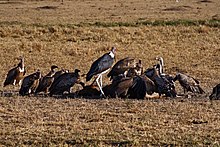Marabou stork
[7] The marabou stork is a massive bird: large specimens are thought to reach a height of 152 centimetres (5 feet) and a weight of 9 kg (20 lb).
The marabou is unmistakable due to its size, bare head and neck, black back, and white underparts.
It has a huge bill, a pink gular sac at its throat (crumenifer(us) means "carrier of a pouch for money"), a neck ruff, and white legs and black wings.
In the African dry season (when food is more readily available as the pools shrink), it builds a tree nest in which two or three eggs are laid.
It occasionally eats other birds including Quelea nestlings, pigeons, doves, pelican and cormorant chicks, and even flamingos.
During the breeding season, adults scale back on carrion and take mostly small, live prey since nestlings need this kind of food to survive.
[10] As with vultures, marabou storks perform an important natural function by cleaning areas via their ingestion of carrion and waste.
Increasingly, marabous have become dependent on human garbage and hundreds of the huge birds can be found around African dumps or waiting for a hand out in urban areas.
[10] Fully grown marabou storks have few natural enemies, and have high annual survival rate,[17] though lions have reportedly preyed on some individuals in ambush.
[18] A number of endoparasites have been identified in wild marabous including Cheilospirura, Echinura and Acuaria nematodes, Amoebotaenia sphenoides (Cestoda) and Dicrocoelium hospes (Trematoda).


